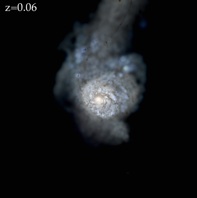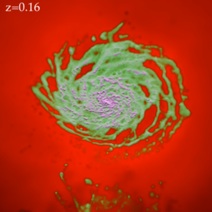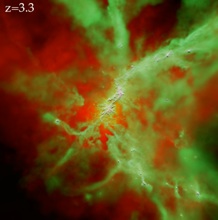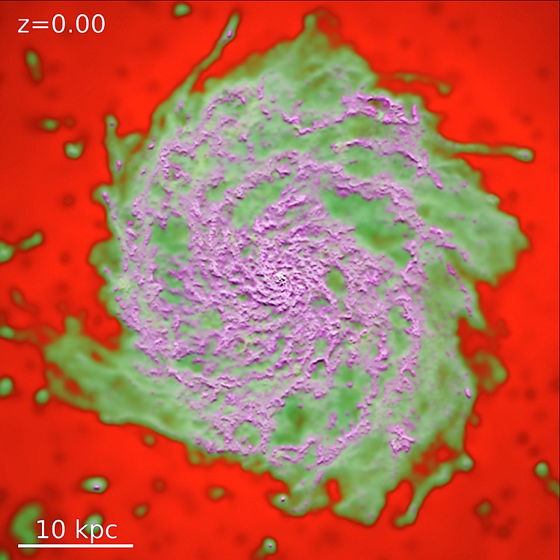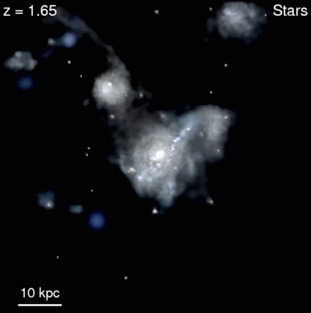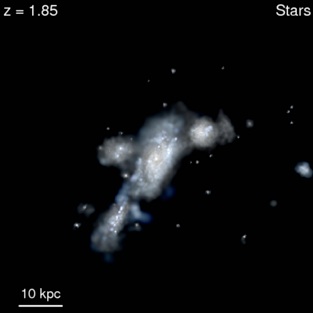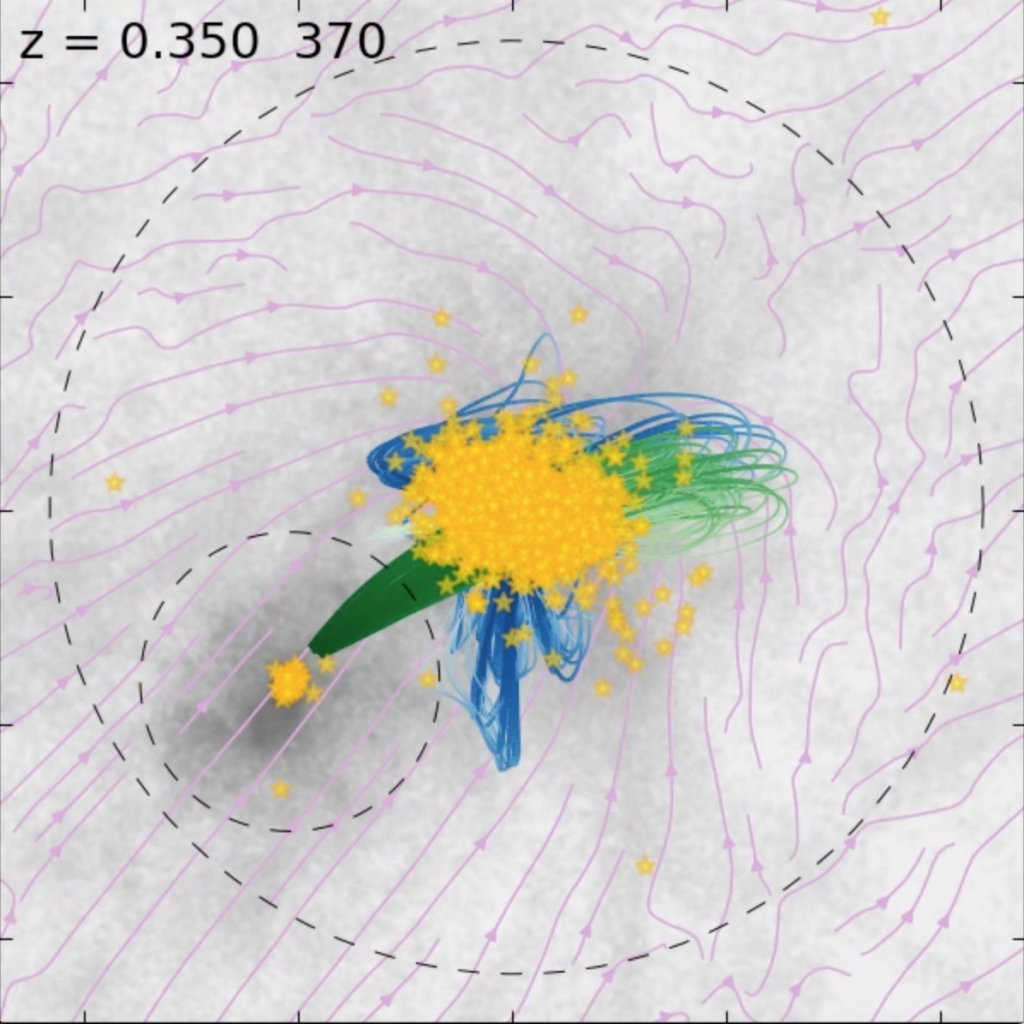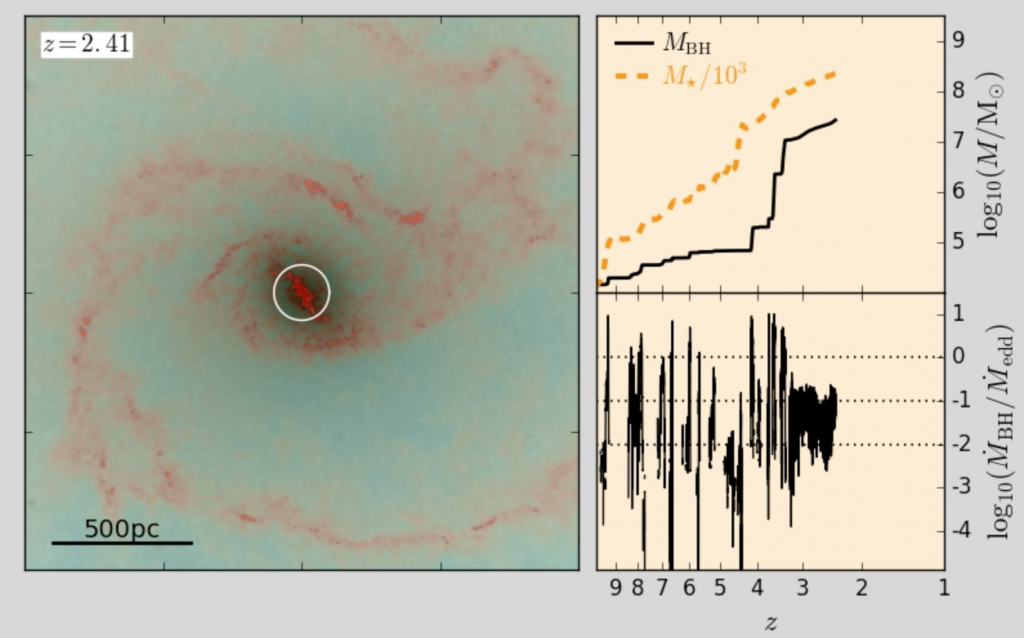This page contains some animations and visualizations of FIRE simulations. This is far from the only site where beautiful and educational visualizations of these simulations are available, and we only include a few here: if you want to seek out others, check out some of the websites described below.
Firefly (image above) is a visualization app for particle-based simulations, which we’ve used extensively for the FIRE simulations. Firefly allows users to interactively explore a simulation snapshot, moving through it in a smooth and intuitive manner. A unique feature of Firefly is that the same application can run seamlessly run on a wide range of platforms, ranging from an user’s personal laptop to an ultra-high resolution display wall with 3D spectroscopic capability. Thanks to this extraordinary versatility, Firefly can be used for professional data analysis as well as for education and outreach.
Check out a demo version of Firefly with some simulation data here. Or, learn more about the Firefly project here. Or, download full Firefly data sets for public simulation outputs of Milky Way mass halos via our “Milky Way” or “Data” portals on this website.
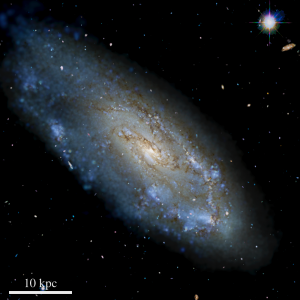
A gallery of (simulated) galaxies: showing mock HST images of our FIRE simulations, is available via Phil Hopkins’s website here. Go there to explore some of the diverse range of galaxy types that appear in the simulations, like the image here.
The image at the right is one example. The colors are a mock version of what would appear in a typical Hubble image, made by ray tracing through the fully-simulated gas and dust and stars of the simulation (for the experts, its a mock u/g/r composite image). Blue shows young stars and star clusters. Red and brown dust lanes obscure and redden the light. See dozens of galaxies with diverse morphologies emerge!
A number of example movies are shown below. These are just a few examples of a huge library of simulation animations. For more extensive sets of animations, with more detailed descriptions, please go to Phil Hopkins’s website here.
The movies show simulations of individual galaxies forming, starting at a time when the Universe was just a a few million years old (redshift of 100). They follow the region that will become a single galaxy by the present time, tracing the evolution of dark matter and gas, which eventually turns into stars. Those stars then ‘light up’ the medium around them: they alter it with both their radiation heating up and pushing on the medium, as well as supernova explosions.
A Milky Way Like Galaxy merging with its Large Magellanic Cloud:
Flying Through the Last Billion Years
This shows a mock three-color image (u/g/r bands) of what this galaxy would look like in visible light wavelengths. Blue regions are young star clusters which have blown away the gas and dust out of which they formed. Red regions are obscured by large amounts of dust. The duration of the movie follows the last billion years of cosmic time, and while time is passing we have flown a camera “through” the resulting galaxy, panning around it as well, so you can see the structure inside the system. This version of the movie was made from one of our high-resolution (mass resolution for the gas and stars of 7000 solar masses) simulations of a Milky Way mass galaxy. For more like this, go here.
A Milky-Way Mass Galaxy in Formation (m12q)
These movies show the formation of a galaxy, similar in mass to the Milky Way, from early times (redshift z=100) to the present. The scale is fixed at 50 physical kiloparsecs on a side (so at early times, the galaxies occupy only a small fraction of this). Massive outflows driven by feedback from stars are plainly evident, and especially at early times have a dramatic impact on the surrounding inter-galactic medium. At later times, things “calm down” and a more relaxed disk starts to form. Note that this is a much lower-resolution simulation compared to the one above, so up close you can’t see as much fine detail. But go here for higher-resolution animations like this.
Gas and the Formation of Disks from the Cosmic Web
Below, you can see movies of a simulation starting from slightly different initial conditions, with a different color scheme designed to highlight the cosmic web feeding the galaxies.
The Origin of Thin Galactic Disks (m12i)
These videos show the disk of a present-day Milky Way-mass galaxy, in stars and gas, formed in a simulation with an “intermediate” formation history.
Despite the violence of the outflows from the galaxy, we see a remarkably thin disk of young stars. It has been a challenge for decades to produce galaxies with thin disks, and many previous studies suggested that thin disks may be incompatible with strong feedback. The FIRE simulations show that thin galactic disks can form in cosmological simulations, and that they are compatible with strong stellar feedback.
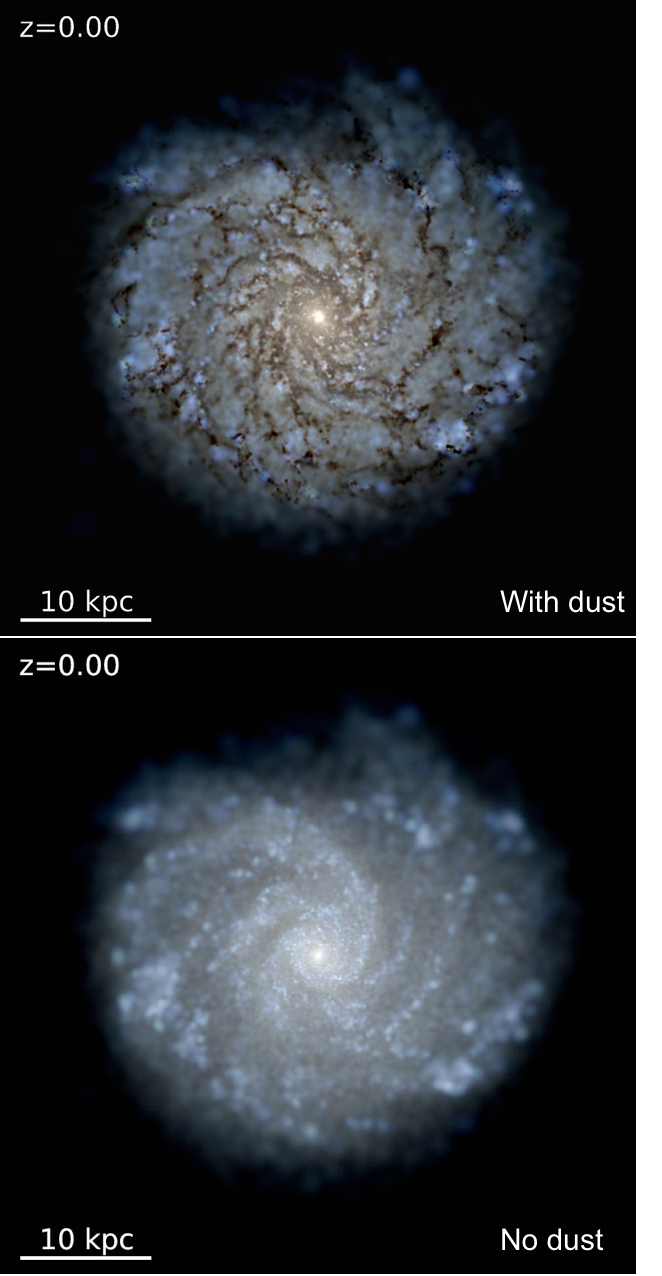
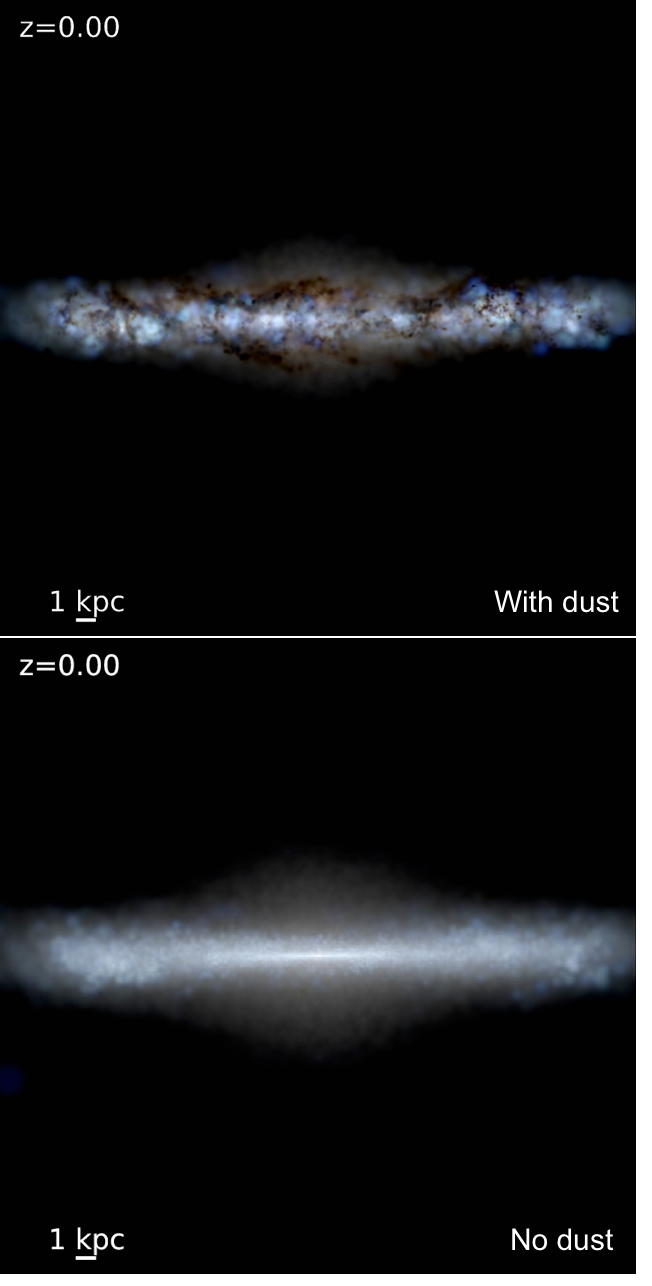
Starlight (Left: face-on. Right: edge-on)
And here is the gas in the same simulation (color coding as above):
A More Violent Alternative (m12v)
These movies are of a galaxy with similar mass, but one which experienced a more violent history. Unlike the previous system, this has many mergers — violent collisions — with other galaxies, over a wide range of times. As a result, the well-ordered disk we saw before never has as much chance to survive and grow before it is destroyed by these encounters.
These show mock three-color image (u/g/r bands) of what this galaxy would look like in visible light wavelengths, like the movie above, from two different projections to help see the mergers clearly.
A Dwarf Galaxy in Formation (m10)
These movies compare, instead, the formation of a much smaller ‘dwarf’ galaxy, with a halo mass of 10^10 solar masses, and present-day mass in stars of a few million solar masses. Outflows are enormously important here — the galaxy is a thousand times smaller in stellar mass than it would be without feedback! But feedback acts quite differently, as can be plainly seen. Outflows are very spherical, because the galaxy and its halo are small compared to the background filament it is forming out of. So accretion onto them is quasi-spherical. The outflows are primarily driven by warm/hot gas, in a series of ‘shells’. There isn’t much cold gas in the galaxy, because even a small mass in young, massive stars can heat up all the gas enough to ionize it and blow quite a large fraction out of the galaxy entirely!
You can also plainly see the effects of reionization at redshift z~8-9, when the Universe ‘lights up’ and the gas in the intergalactic medium becomes ionized.
These movies show the gas in the galaxy. Magenta is cold molecular/atomic gas (T<1000 K), green is warm ionized gas (10^4-10^5 K), and red is ‘hot‘ gas (>10^6 K).
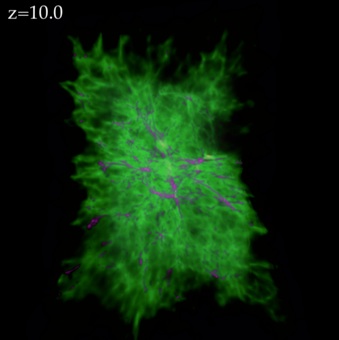
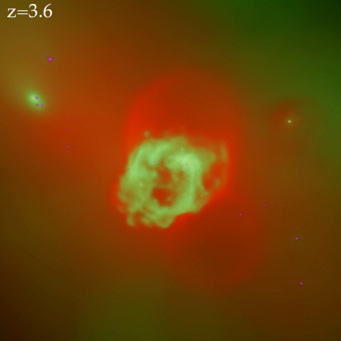
Gas (Left: large scales, 100 kpc on a side. Right: small scales, 20 kpc on a side)
In the absence of these ‘feedback’ effects, nearly 100% of the gas gravitationally bound to the final dark matter ‘halo’ would turn into stars, in stark disagreement with what is observed. But the movies plainly illustrate that feedback leads to massive galactic super-winds that blow out a great deal of the gas.
Animations of gas flows in the circum-galactic medium
These animations, based on the cosmic baryon cycle analysis reported in Anglés-Alcázar et al. (2017a), illustrate gas flows that fuel star formation in galaxies (fresh accretion, wind recycling, intergalactic transfer, …). See the paper for descriptions of the different types of gas flows.
Animation of supermassive black hole growth in FIRE
This animation shows how the mass of the central supermassive black hole grows relative to the stellar mass of the host galaxy in one of the simulations from Anglés-Alcázar et al. (2017b). The animation shows how the black hole accretion rate at early times is very intermittent due to repeated evacuation of gas from the galactic nucleus by stellar feedback. At later times, the galaxy develops a stable gaseous nuclear disk which fuels the black hole at a more steady rate.
At the end of the simulation, the supermassive black hole has a mass similar to what is expected based on scaling relations observed in the local universe for the stellar mass of the galactic bulge. The simulation shown here follows a main halo of total mass ~10^12.5 Msun z=2, representative of luminous quasars at that redshift.
Visualizations of full-volume cosmological boxes (the “FIREbox” initial conditions):
This shows a fixed moment (z=2), rendering the cosmic web at a fixed distance (blue) and zooming in and out (purple, where this shows the gas and stars with the gas in the smooth colormap from purple through yellow and the stars as red points) in a ~25 Mpc^3 volume run with the FIRE-2 code and physics, uniformly filled.

